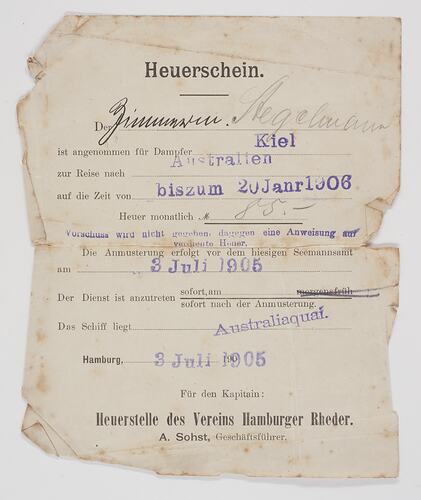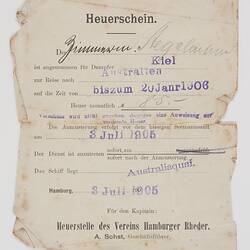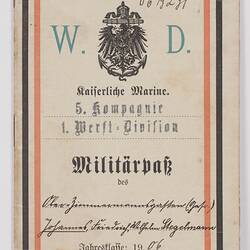Summary
Pay/Hire certificate issued to J. Stegelman by the Hire Office of a Hamburg shipping firm dated 3 July 1905. The certificate states Stegelman will be employed as a carpenter on the steamer 'Kiel' from the 20 January 1906 during the ship's voyage to Australia.
Description of Content
Pay/Hire certificate issued by the Hiring Office of organisation of Hamburg Shipping firm for J Stegelmann to work as a carpenter on Steamer 'Kiel' to Australia for the period of 20/1/1905 to 3/7/1905.
Physical Description
Yellowing paper with black printed text. Personal details written in pen. Some purple stamps. All in German. Dog eared around the sides.
Significance
Johannes Stegelman's story is a great example of more unorthodox migration. Jumping ship was a common way to start a new life in Australia, especially for sailors on merchant ships, and dates back to the 1850s gold rush with sailors jumping ship to head for the goldfields (John Simpson Kirkpatrick of 'Simpson and his donkey' fame arrived in Australia by jumping ship). Stegelman's objects all relate to his career in both the German Navy and the merchant navy including the hire document that brought him to Australia. The story is also interesting for its cross-cultural marriage and the bringing together of two very different migrant stories from different periods in time.
Gladys Leichti's objects and story represents the push to attract young British girls for domestic service in the 1920s and the role of philanthropic organizations such as the Salvation Army in meeting this demand.
More Information
-
Collecting Areas
Migration & Cultural Diversity, Public Life & Institutions, Transport
-
Acquisition Information
Donation from Margaret Steglman, 29 Nov 2006
-
Issued To
-
Other Association (See Comments)
20 Jan 1906
Date employment on the Kiel commences. -
Inscriptions
Text: Heuerschein.
-
Classification
-
Category
-
Discipline
-
Type of item
-
Overall Dimensions
17 cm (Length), 14.2 cm (Width)
-
Keywords
Apprenticeships, German Communities, German Immigration, Immigration, Merchant Seamen, Shipboard Travel, Shipping Companies, Shipping Industry, Trades, Tradespeople



